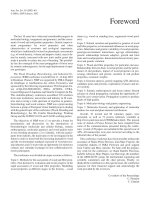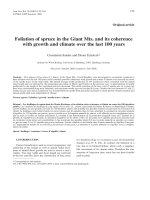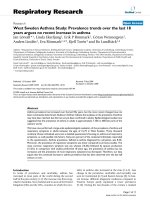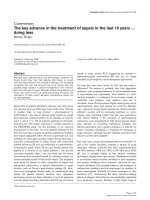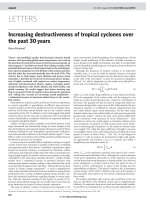Flow of funds figures show the largest drop in household borrowing in the last 40 years
Bạn đang xem bản rút gọn của tài liệu. Xem và tải ngay bản đầy đủ của tài liệu tại đây (97.63 KB, 1 trang )
Flow of Funds Figures Show
the Largest Drop in Household
Borrowing in the Last 40 Years
Federal Reserve Flow of Funds figures released on December 11
report a drop in borrowing that is steeper than our previous pro-
jections in April 2008. After slowing to 0.5 percent of GDP in the
second quarter of 2008, the change in household debt outstanding
in the third quarter was a negative 0.8 percent of GDP (Figure 1).
Borrowing by nonfinancial business was still positive, although the
change in this sector’s outstanding debt slowed to 2.2 percent of
GDP, down from 4.2 percent in the second quarter. As Figure 1
shows, the previous two recessions saw a marked fall-off in business
borrowing—with minor consequences for households—while the
current recession’s drop in credit is having a greater effect on
households’ finances.
As expected, a steep drop in mortgage debt accounts for most
of the decline in household borrowing: the change in household
mortgages outstanding is a negative 1.8 percent of GDP.Consumer
credit growth, on the other hand, has slowed, but it is still a posi-
tive 2.3 percent of GDP. Sharply lower household borrowing h a s
brought about a reversal of the upward trend in household debt
(Figure 2), which nevertheless remains very large relative to income.
If households’ consumption behavior has shifted toward bringing
debt back to a more susta inable path, we can expect a further
decline in borrowing in the coming quarters.
According to the Levy Institute’s macro model, a fall in bor-
rowing has an immediate effect—which in this case accounts for a
large part of the 3 percent drop in private expenditure that occurred
in the third quarter. But it will also have delayed effects in the fol-
lowing quarters. As a result, the continuing decline in real GDP and
accompanying rise in unemployment may be substantial (Figure 3).
For further details on our latest projections, see Wynne Godley,
Dimitri B. Papadimitriou, and Gennaro Zezza, Prospects for the U.S.
and the World: A Crisis That Conventional Remedies Cannot Resolve,
Levy Institute Strategic Analysis, De cember 2008.
-4
-2
0
2
4
6
8
10
12
1
960
1
962
1
9
6
4
1
96
6
1
96
8
1
970
1
97
2
1
9
7
4
1
97
6
1
978
1
980
1
982
1
98
4
1
9
8
6
1
988
1
99
0
1
992
1
99
4
1
996
1
99
8
2
000
2
002
2
0
04
2
006
2
008
Percent of GDP
20
30
40
50
60
70
80
90
100
110
1
960
1
962
1
9
6
4
1
96
6
1
9
6
8
1
970
1
97
2
1
9
74
1
97
6
1
97
8
1
980
1
982
1
98
4
1
9
8
6
1
9
88
1
990
1
9
9
2
1
994
1
9
9
6
1
9
9
8
2
000
2
0
02
2
004
2
0
0
6
2
0
0
8
Percent of GDP
2%
3%
4%
5%
6%
7%
8%
9%
10%
11%
2000 2002 2004 2006 2008 2010 2012
Figure 1 Change in Debt Outstanding
Figure 2 Household Debt Outstanding
Figure 3 Unemployment Rate
Households
Nonfinancial business
Debt outstanding
Mortgage debt outstanding
Strategic Analysis
The Levy Econo mics Institu te of Bard College
J
anuary 2009


![live audio [electronic resource] the art of mixing a show](https://media.store123doc.com/images/document/14/ne/fl/medium_flf1401588846.jpg)
